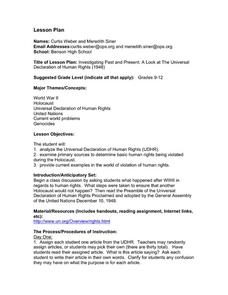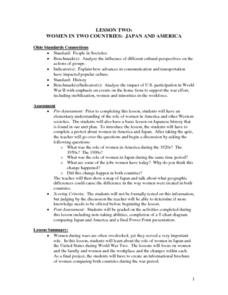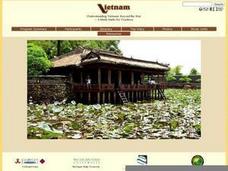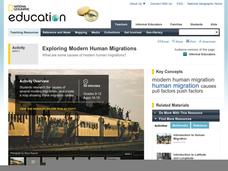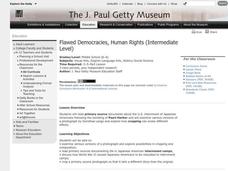Curated OER
Inventions Change the World: The Enigma Machine
Third graders explore WWII by analyzing technological advances. In this invention lesson plan, 3rd graders discuss the use of the Enigma machine which decoded private German messages that communicated with U-boats. Students utilize a...
Curated OER
What is War?
Students establish what war signifies to them. They demonstrate this by voting on statements. Students are invited to ponder about how they feel about issues, their world history, and to defend their positions.
Curated OER
Investigating Past and Present: A Look at The Universal Declaration of Human Rights
Students compare the Universal Declaration of Human Rights to the war crimes of WWII. In this lesson on Human Rights, students evaluate the causes of WWII, war crimes, and determine whether the outcome might have been different otherwise.
Center for History and New Media
The Impact of the Jim Crow Era on Education, 1877–1930s
Even though American slaves were officially emancipated in 1865, the effects of slavery perpetuated throughout the 19th and 20th centuries. Middle and high schoolers learn about the ways that discrimination and the Jim Crow laws...
Curated OER
U.S. Immigration Policy and Hitler's Holocaust
Students read about immigration to the U.S. during the Holocaust. In this immigration activity, students write answers to discussion questions. Students role play members of the 1951 U.N. conference and create guidelines for an...
Curated OER
The Ethics of the Bomb: What Would You Do?
Learners research the use of the atomic bomb in WWII, analyze the human costs of dropping the bomb and identify the pros and cons. They develop a PowerPoint presentation on the effects of an atomic bomb dropped on their hometown.
Curated OER
Baby Boom and the Culture of the 1950's
Eleventh graders explain the causes, course, and consequences of the United States' role in World War II.
Curated OER
Women in Two Countries: Japan and America
Students explore the role of women in Japan and the United States during World War Two. They focus on women and the family and women and the workplace and the changes within each. Students create an informational brochure of women...
Curated OER
Language Arts: Novel Guides
Learners discuss the Revolution and consider the causes of the war, the attitudes of the colonists, and the position of the British. Then students explore American involvement in wars since the country's inception.
Curated OER
A Brief History of Vietnam (1858-2004) and Its Evolving Communist System
Students examine the French colonization of Vietnam, the Vietnam War, and the current evolving Communist system. They develop political maps, outline the major events of the Vietnam War, write an essay, and compare/contrast democracy...
Curated OER
Surviving Hitler
Are you thinking of reading Surviving Hitler with your class? If so, you will find these worksheets to be useful. They include great activities which are designed to help your readers respond to the book. Predicting events and a chart...
National Geographic
Exploring Modern Human Migrations
Using maps, images, websites, and handouts, learners work to understand the nature of human migrations. They compare and contrast human migration from the past to the present, identify causes for migration, and trace migration routes on...
Curated OER
Sadako and the Thousand Paper Cranes
Have your class explore the effects of war by reading Eleanor Coerr's story, "Sadako and the Thousand Paper Cranes." This is a story about a sixth grader who lives in Hiroshima when the atomic bomb is dropped. Learners answer questions,...
Curated OER
The Westward Movement
Students study the westward movement through examining stamps. In this westward movement lesson plan, students draw conclusions, determine cause and effect relationships and examine the westward movement of the United States by...
Curated OER
America and the Sino-Japanese Conflict, 1933-1939
Students examine the U.S. stance regarding the Sino-Japanese conflict. In this diplomacy lesson, students analyze the sanctions employed by United States on Japan when they took over Manchuria. Students determine how actions by the...
Curated OER
The Good Earth - Essay Questions
In this literature worksheet, students respond to 6 short answer and essay questions about Buck's The Good Earth. Students may also link to an online interactive quiz on the novel at the bottom of the page.
Albert Shanker Institute
Economic Causes of the March on Washington
Money can't buy happiness, but it can put food on the table and pay the bills. The first of a five-lesson unit teaches pupils about the unemployment rate in 1963 and its relationship with the March on Washington. They learn how to create...
Curated OER
Checks and Balances: Japanese-American Incarceration
Middle schoolers examine the three branches of the Federal Government and their decision to place Japanese-Americans in camps during World War II. They analyze debates made by leaders during this time period.
National First Ladies' Library
World Starvation
Students investigate the concept of world starvation and some of the organizations that are founded in order to help solve the problem. They conduct research using a variety of resources. The information is used in order to conduct class...
Curated OER
Flawed Democracies, Human Rights
Students investigate the bombing of Pearl Harbor. In this U.S. History activity, students discover the Japanese internment camps and why our government chose to relocate the Japanese. Students examine photographs from the era and their...
Curated OER
Houghton Mifflin Social Studies/Chapter 11, Lesson 1: California in Wartime (pp. 250-253)
Fourth graders explore the crisis of Japanese Americans during World War II. The benefits of the California economy are explored. The lesson has a discussion portion that is culturally relevant for many types of students.
Curated OER
Nationalism in North Africa and the Middle East
Africa and the Middle East are the focus of this Social Studies PowerPoint. After viewing many slides that are packed with historical facts, viewers answer questions such as, "How was the struggle for independence in Algeria different...
Curated OER
Hiroshima, From All Sides
Students comprehend how the Atomic Bomb affected humanity and ended WWII. They comprehend how the Atomic Bomb affected: scientists, Japanese citizens, and US leaders. Students receive a copy of Hiroshima, Readers Theater Rubiv. They...
Curated OER
Jewish Ghettos and Death/Concentration Camps
Students trace and explain the antecedents, causes, major events, and global consequences of World War II, including the Holocaust. They assess the conditions of Jewish inhabitants of the Ghettos and death/concentration camps and the...




